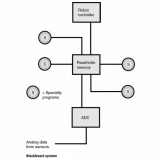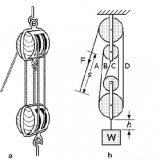Efficiency of Machines & Mechanical Advantage 51006
Back to LEARNING CENTER Page
EFFICIENCY of MACHINES
Simple machines are evaluated on the basis of efficiency and mechanical advantage. While it is possible to obtain a larger force from a machine than the force exerted upon it, this refers only to force and not energy; according to the law of conservation of energy, “more work cannot be obtained from a machine than the energy supplied to it”.
Because Work = Force * Distance, for a machine to exert a larger force than its initiating force or operator, that larger force must be exerted through a correspondingly shorter distance. As a result of friction in all moving machinery, the energy produced by a machine is less than that applied to it. Consequently, by interpreting the law of conservation of energy, it follows that:
Input Energy = output energy + wasted energy
This statement is true over any period of time, so it applies to any unit of time; because power is work or energy per unit of time, the following statement is also true:
Input Power = output power + wasted power
The efficiency of a machine is the ratio of its output to its input, if both input and output are expressed in the same units of energy or power. This ratio is always less than unity, and it is usually expressed in percent by multiplying the ratio by 100.
Percent Efficiency = (output energy / input energy) * 100
Percent Efficiency = (output power / input power) * 100
A machine has high efficiency if most of the power supplied to it is passed on to its load and only a fraction of the power is wasted. The efficiency can be as high as 98 percent for a large electrical generator, but it is likely to be less than 50 percent for a screw jack. For example, if the input power supplied to a 20-hp motor with an efficiency of 70 percent is to be calculated, the foregoing equation is transposed.
Input power = (output power / percent efficiency) * 100
= 20 hp / 70 * 100 = 28,6 hp
(Attention: There are lots of “Free Energy” or “Perpetual Motion” Videos on the web. But Perpetual Motion is possible. Because they are all against the Law of Conservation of Energy ) - Perpetual motion describes “motion that continues indefinitely without any external source of energy; impossible in practice because of friction.
Check Perpetual Motion on Robotee Encyclopedia of Robotics
MECHANICAL ADVANTAGE
What is Mechanical Advantage ?
Mechanical advantage is a measure of the force amplification achieved by using a tool, mechanical device or machine system. Ideally, the device preserves the input power and simply trades off forces against movement to obtain a desired amplification in the output force. Machine components designed to manage forces and movement in this way are called mechanisms.
An ideal mechanism transmits power without adding to or subtracting from it. This means the ideal mechanism
-does not include a power source,
– is frictionless,
-constructed from rigid bodies that do not deflect or wear.
The performance of real systems is obtained from this ideal by using efficiency factors that take into account friction, deformation and wear.
The mechanical advantage of a mechanism or system is the ratio of the load or weight W, typically in pounds or kilograms, divided by the effort or force F exerted by the initiating entity or operator, also in pounds or kilograms. If friction has been considered or is known from actual testing, the mechanical advantage,
MA, of a machine is:
MA = load / effort = W / F
Ideal Mechanical Advantage
The ideal mechanical advantage (IMA), or theoretical mechanical advantage, is the mechanical advantage of a device with the assumption that its components do not flex, there is no friction and no wear. It is calculated using the physical dimensions of the define and defines the maximum performance the device can achieve.
The assumptions of an ideal machine are equivalent to the requirement that the machine does not store or dissipate energy, thus the power into the machine equals the power out. Therefore, the power P is constant through the machine and force times velocity into the machine equals the force times velocity out, that is
The ideal mechanical advantage is the ratio of the force, or effort, out of the machine relative to the force or effort into the machine, that is
The constant power relationship provides yields a formula for this ideal mechanical advantage in terms of the speed ratio,
The speed ratio of a machine can be calculated from its physical dimensions, thus the assumption of constant power allows the use of speed ratio to determine the maximum value for the mechanical advantage.
Actual Mechanical Advantage
The actual mechanical advantage (AMA) is the mechanical advantage determined by physical measurement of the input and output forces. Actual mechanical advantage takes into account energy loss due to deflection, friction, and wear.
The AMA of a machine is calculated as the ratio of the measured force output to the measured force input,
where the input and output forces are determined experimentally.
The ratio of the experimentally determined mechanical advantage to the ideal mechanical advantage is the efficiency η of the machine,
Links
Youtube Video: http://youtu.be/wyNEJyiqcNw









